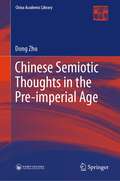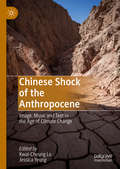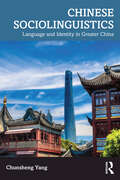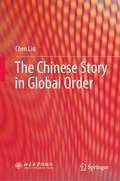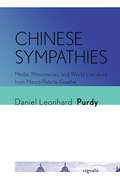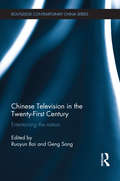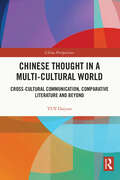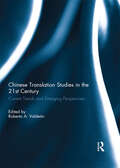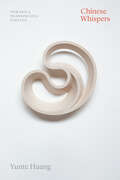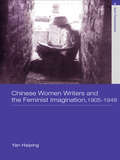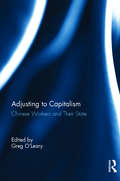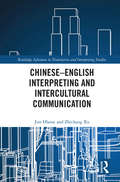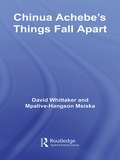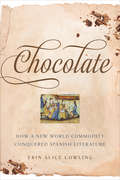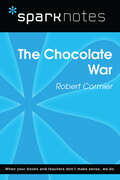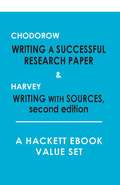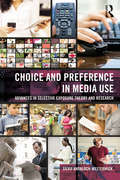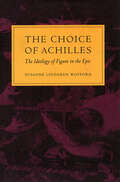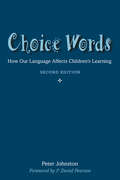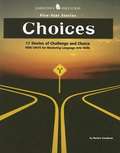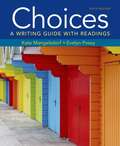- Table View
- List View
Chinese Semiotic Thoughts in the Pre-imperial Age (China Academic Library)
by Dong ZhuThis book examines practices on the relationship between sign and meaning in the Pre-Imperial period of China from the semiotics perspective. Although the Chinese civilization did not develop a comprehensive semiotics system in that period, they are highly semiotic in many ways. The thinking and application of signs of Chinese people can be found in many classics, such as The Book of Changes, The Analects of Confucius, Tao De Jing and Zhuangzi. This book begins its study by re-examining the semiotic thoughts contained in The Book of Changes and inquiries into the thoughts of the major philosophers of different schools. It provides insights into the findings of these philosophers concerning the relationship between sign and meaning. In particular, it concentrates on how the prosperity of the various contending semiotic thoughts complemented each other in forming a sign system. In addition, the book also emphasizes the wholeness and associativity of observing things and studying relevant signs of Chinese people. As the first monograph in any language to systematically summarize Chinese semiotic thought in the Pre-Imperial period, this book helps promote understanding of the traditional Chinese culture and mindset.
Chinese Shock of the Anthropocene: Image, Music and Text in the Age of Climate Change
by Kwai-Cheung Lo Jessica YeungThis book examines China’s role and its cultural productions in the process of environmental destruction and transformation, focusing on how various cultural media play a significant role in shaping and reproducing Chinese subject formation in relation to changing ecological conditions. It argues that China under the leadership of Xi Jinping vowed in 2017 to play a leading role in preserving the planet for the future, but many of its actions such as its “Belt and Road” initiative have aroused apprehension rather than inspired confidence. Against this backdrop of environmental concern, this volume brings together a cutting-edge critical analysis of Chinese literature, music and cinema, offering a transdisciplinary and comprehensive vision of Chinese arts and literature under the current conditions of the Anthropocene. This volume sets a high scholarly standard in the field, and constitutes a valuable reference for scholars and students of Chinese cultural studies, Chinese studies and Anthropocene studies.
Chinese Sociolinguistics: Language and Identity in Greater China
by Chunsheng YangChinese Sociolinguistics examines the ways in which language contributes to shaping social, cultural, and ethnic identities in Greater China. This book is the first textbook to be exclusively devoted to the issues of language, society, and identity in mainland China, Taiwan, Hong Kong, Singapore, and overseas Chinese communities (the Greater China). The book includes topics on the role of language in Chinese culture; the linguistic indexing of socioeconomic class; dialects and regional language variation; the impacts of state policies; linguistic borrowings; bilingualism and bicultural identity; and language shift and attrition. The emergence of new forms of language as influenced by modern technologies and possible future developments is also discussed in this book. This book will appeal to undergraduate and graduate students taking courses in Chinese sociolinguistics, particularly with a focus on language, identity, and society in Greater China. This book will also be of interest to members of the Chinese Language Teachers Association and the American Council of Teaching Foreign Languages (ACTFL).
The Chinese Story in Global Order
by Chen LiuThis book provides a historical review of the transformation of China’s image around the world since the 1978 Reform and Opening Up. Based on a synthetic model that the author constructs for evaluating national images, together with a historical review and quantitative analysis, it discusses the issues and challenges confronting China’s image around the world since the Opening Up. To help rectify the situation that most of the research on China’s reform efforts focuses on hard power (esp. economic power), this book, which mainly focuses on China’s soft power, reviews and assesses its global image from the three perspectives of politics, economy and culture. In the process, it sheds valuable new light on the presentation of China’s image and the world’s perceptions of China.
Chinese Sympathies: Media, Missionaries, and World Literature from Marco Polo to Goethe (Signale: Modern German Letters, Cultures, and Thought)
by Daniel Leonhard PurdyChinese Sympathies examines how Europeans—German-speaking writers and thinkers in particular—identified with Chinese intellectual and literary traditions following the circulation of Marco Polo's Travels. This sense of affinity expanded and deepened, Daniel Leonhard Purdy shows, as generations of Jesuit missionaries, baroque encyclopedists, Enlightenment moralists, and translators established intellectual regimes that framed China as being fundamentally similar to Europe. Analyzing key German literary texts—theological treatises, imperial histories, tragic dramas, moral philosophies, literary translations, and poetic cycles—Chinese Sympathies traces the paths from baroque-era missionary reports that accommodated Christianity with Confucianism to Goethe's concept of world literature, bridged by Enlightenment debates over cosmopolitanism and sympathy, culminating in a secular principle that allowed readers to identify meaningful similarities across culturally diverse literatures based on shared human experiences.Thanks to generous funding from Penn State University, the ebook editions of this book are available as Open Access volumes from Cornell Open (cornellopen.org) and other repositories.
Chinese Television in the Twenty-First Century: Entertaining the Nation (Routledge Contemporary China Series)
by Ruoyun Bai Geng SongThe past two decades witnessed the rise of television entertainment in China. Although television networks are still state-owned and Party-controlled in China, the ideological landscape of television programs has become increasingly diverse and even paradoxical, simultaneously subservient and defiant, nationalistic and cosmopolitan, moralistic and fun-loving, extravagant and mundane. Studying Chinese television as a key node in the network of power relationships, therefore, provides us with a unique opportunity to understand the tension-fraught and , paradox-permeated conditions of Chinese post-socialism. This book argues for a serious engagement with television entertainment. rethinking, It addresses the following questions. How is entertainment television politically and culturally significant in the Chinese context? How have political, industrial, and technological changes in the 2000s affected the way Chinese television relates to the state and society? How can we think of media regulation and censorship without perpetuating the myth of a self-serving authoritarian regime vs. a subdued cultural workforce? What do popular televisual texts tell us about the unsettled and reconfigured relations between commercial television and the state? The book presents a number of studies of popular television programs that are sensitive to the changing production and regulatory contexts for Chinese television in the twenty-first century. As an interdisciplinary study of the television industry, this book covers a number of important issues in China today, such as censorship, nationalism, consumerism, social justice, and the central and local authorities. As such, it will appeal to a broad audience including students and scholars of Chinese culture and society, media studies, television studies, and cultural studies.
Chinese Thought in a Multi-cultural World: Cross-Cultural Communication, Comparative Literature and Beyond (China Perspectives)
by YUE DaiyunReflecting on the “clash of civilizations” as its point of departure, this book is based on a series of sixteen of the author’s interconnected, thematically focused lectures and calls for new perspectives to resist imperialistic homogeneity. Situated within a neo-humanist context, the book applies interactive cognition from an Asian perspective within which China can be perceived as an essential “other,” making it highly relevant in the quest for global solutions to the many grave issues facing humankind today. The author critiques American, European, and Chinese points of view, highlighting the significance of difference and the necessity of dialogue, before, ultimately, rethinking the nature of world literature and putting forward interactive cognition as a means of “reconciliation” between cultures. Chinese culture, as a frame of reference endowed with traditions of “harmony without homogeneity”, may help to alleviate global cultural confrontation and even reconstruct the understanding of human civilization. The book will be essential reading for scholars and students of Comparative Literature, Chinese Studies, and all those who are interested in cross-cultural communication and Chinese culture in general.
Chinese Translation Studies in the 21st Century: Current Trends and Emerging Perspectives
by Roberto A. ValdeónChinese Translation Studies in the 21st Century, which presents a selection of some of the best articles published in the journal Perspectives in a five-year period (2012-2017), highlights the vitality of Translation Studies as a profession and as a field of enquiry in China. As the country has gradually opened up to the West, translation academic programmes have burgeoned to cater for the needs of Chinese corporations and political institutions. The book is divided into four sections, in which authors explore theoretical and conceptual issues (such as the connection between translation and adaptation, multimodality, and the nature of norms), audiovisual translation (including studies on news translation and the translation of children’s movies), bibliographies and bibliometrics (to assess, for example, the international visibility of Chinese scholars), and interpreting (analyzing pauses in simultaneous interpreting and sign language among other aspects). The book brings together well-established authors and younger scholars from universities in mainland China, Hong Kong, Macao and Taiwan.The chapters in this book were originally published in various issues of Perspectives: Studies in Translatology.
Chinese Whispers: Toward a Transpacific Poetics (Thinking Literature)
by Yunte HuangChinese Whispers examines multiple contact zones between the Anglophone and Sinophone worlds, investigating how poetry both enables and complicates the transpacific production of meaning. In this new book, the noted critic and best-selling author Yunte Huang explores the dynamics of poetry and poetics in the age of globalization, particularly questions of translatability, universality, and risk in the transpacific context. “Chinese whispers” refers to an American children’s game dating to the years of the Cold War, a period in which everything Chinese, or even Chinese sounding, was suspect. Taking up various manifestations of the phrase in the twentieth and twenty-first centuries, Huang investigates how poetry, always to a significant degree untranslatable, complicates the transpacific production of meanings and values. The book opens with the efforts of I. A. Richards, arguably the founder of Anglo-American academic literary criticism, to promote Basic English in China in the early twentieth century. It culminates by resituating Ernest Fenollosa’s famous essay “The Chinese Written Character as a Medium for Poetry,” exploring the ways in which Chinese has historically enriched but also entrapped the Western conception of language.
Chinese Women Writers and the Feminist Imagination, 1905-1948
by Haiping YanChinese Women Writers and the Feminist Imagination, 1905-1948 provides a compelling study of leading women writers in modern China, charting their literary works and life journeys to examine the politics and poetics of Chinese transcultural feminism that exceed the boundaries of bourgeois feminist selfhood. Unlike recent literary studies that focus on the discursive formation of the modern Chinese nation state and its gendering effects, Haiping Yan explores the radical degrees to which Chinese women writers re-invented their lives alongside their writings in distinctly conditioned and fundamentally revolutionary ways. The book draws on these women's voluminous works and dramatic lives to illuminate the range of Chinese women's literary and artistic achievements and offers vital sources for exploring the history and legacy of twentieth-century Chinese feminist consciousness and its centrality in the Chinese Revolution. It will be of great interest to scholars of gender studies, literary and cultural studies and performance studies.
Chinese Workers and Their State: Adjusting to Capitalism
by Greg O'LearyThis text examines the most economically critical and politically sensitive issues of China's reform process - labour market development, changing industrial relations, and labour-state and labour-capital conflict. It suggests that a system is emerging in China which is a form of capitalism.
The Chinese Written Character as a Medium for Poetry: A Critical Edition
by Ernest Fenollosa Ezra Pound Jonathan Stalling Lucas KleinFirst published in 1919 by Ezra Pound, Ernest Fenollosa’s essay on the Chinese written language has become one of the most often quoted statements in the history of American poetics. As edited by Pound, it presents a powerful conception of language that continues to shape our poetic and stylistic preferences: the idea that poems consist primarily of images; the idea that the sentence form with active verb mirrors relations of natural force. But previous editions of the essay represent Pound’s understanding—it is fair to say, his appropriation—of the text. Fenollosa’s manuscripts, in the Beinecke Library of Yale University, allow us to see this essay in a different light, as a document of early, sustained cultural interchange between North Americaand East Asia.Pound’s editing of the essay obscured two important features, here restored to view: Fenollosa’s encounter with Tendai Buddhism and Buddhist ontology, and his concern with the dimension of sound in Chinese poetry.This book is the definitive critical edition of Fenollosa’s important work. After a substantial Introduction, the text as edited by Pound is presented, together with his notes and plates. At the heart of the edition is the first full publication of the essay as Fenollosa wrote it, accompanied by the many diagrams, characters, and notes Fenollosa (and Pound) scrawled on the verso pages. Pound’s deletions, insertions, and alterations to Fenollosa’s sometimes ornate prose are meticulously captured, enabling readers to follow the quasi-dialogue between Fenollosa and his posthumous editor. Earlier drafts and related talks reveal the developmentof Fenollosa’s ideas about culture, poetry, and translation. Copious multilingual annotation is an important feature of the edition.This masterfully edited book will be an essential resource for scholars and poets and a starting point for a renewed discussion of the multiple sources of American modernist poetry.
Chinese–English Interpreting and Intercultural Communication: Concepts And Perspectives (Routledge Advances in Translation and Interpreting Studies)
by Jim Hlavac Zhichang XuChinese and English are the world’s largest languages, and the number of interpreter-mediated interactions involving Chinese and English speakers has increased exponentially over the last 30 years. This book presents and describes examples of Chinese–English interpreting across a large number of settings: conference interpreting; diplomatic interpreting; media interpreting; business interpreting; police, legal and court interpreting; and healthcare interpreting. Interpreters working in these fields face not only the challenge of providing optimal inter-lingual transfer, but also need to fully understand the discourse-pragmatic conventions of both Chinese and English speakers. This innovative book provides an overview of established and contemporary frameworks of intercultural communication and applies these to a large sample of Chinese–English interpreted interactions. The authors introduce the Inter-Culturality Framework as a descriptive tool to identify and describe the strategies and footings that interpreters adopt. This book contains findings from detailed data with Chinese-English interpreters as experts not only in inter-lingual exchange, but cross-linguistic and intercultural communication. As such, it is a detailed and authoritative guide for trainees as well as practising Chinese–English interpreters.
Chinua Achebe and the Politics of Narration: Envisioning Language (African Histories And Modernities)
by Thomas Jay LynnThis book examines vital intersections of narration, linguistic innovation, and political insight that distinguish Chinua Achebe's fiction as well as his non-fiction commentaries. Each chapter focuses on a different aspect of these intersections: Achebe's narrative response to Western authors who have written on Africa, his integration of Igbo folklore, the political implications of writing African literature in English, his use of Nigerian Pidgin, and the Nigerian Civil War. It also addresses the teaching of Achebe's works. Achebe drew on diverse resources to offer searching psychological and political insights that contribute not only a decidedly African political viewpoint to the modern novel, but also a more inclusive narrative consciousness. Achebe's adaptations of Igbo oral art are intrinsic to his writing's political engagement because they assert the integrity and authority of the African voice in a global order defined by colonialism. This book reveals how his work has helped to restructure a global vision of Africa.
Chinua Achebe's Things Fall Apart: A Routledge Study Guide (Routledge Guides to Literature #137)
by David Whittaker Mpalive-Hangson MsiskaOffering an insight into African culture that had not been portrayed before, Things Fall Apart is both a tragic and moving story of an individual set in the wider context of the coming of colonialism, as well as a powerful and complex political statement of cross-cultural encounters. This guide to Chinua Achebe’s compelling novel offers: an accessible introduction to the text and contexts of Things Fall Apart a critical history, surveying the many interpretations of the text from publication to the present a selection of critical writing on Things Fall Apart, by Abiola Irele, Abdul JanMohamed, Biodun Jeyifo, Florence Stratton and Ato Quayson, providing a variety of perspectives on the novel and extending the coverage of key critical approaches identified in the survey section cross-references between sections of the guide, in order to suggest links between texts, contexts and criticism suggestions for further reading. Part of the Routledge Guides to Literature series, this volume is essential reading for all those beginning detailed study of Things Fall Apart and seeking not only a guide to the novel, but a way through the wealth of contextual and critical material that surrounds Achebe’s text.
Chocolate: How a New World Commodity Conquered Spanish Literature (Toronto Iberic)
by Erin CowlingIn terms of its popularity, as well as its production, chocolate was among the first foods to travel from the New World to Spain. Chocolate: How a New World Commodity Conquered Spanish Literature considers chocolate as an object of collective memory used to bridge the transatlantic gap through Spanish literary works of the early modern period, tracing the mention of chocolate from indigenous legends and early chronicles of the conquistadors to the theatre and literature of Spain. The book considers a variety of perspectives and material cultures, such as the pre-Colombian conception of chocolate, the commercial enterprise surrounding chocolate, and the darker side of chocolate’s connections to witchcraft and sex. Encapsulating both historical and literary interests, Chocolate will appeal to anyone interested in the global history of chocolate.
Chocolate: And Other Writings On Male Homoeroticism
by Ruth VanitaThis volume makes available for the first time in English the work of a significant Indian nationalist author, Pandey Bechan Sharma, better known in India as "Ugra," meaning "extreme. " His book Chocolate, a 1927 collection of eight stories, was the first work of Hindi fiction to focus on male same-sex relations, and its publication sparked India's first public debates about homosexuality. Many prominent figures, including Gandhi, weighed in on the debates, which lasted into the 1950s. This edition, translated and with an introduction by Ruth Vanita, includes the full text of Chocolate along with an excerpt from Ugra's novel Letters of Some Beautiful Ones (also published in 1927). In her introduction, Vanita situates Ugra and his writings in relation to Indian nationalist struggles and Hindi literary movements and feuds, and she analyzes the controversies that surrounded Chocolate. Those outraged by its titillating portrayal of homosexuality labeled the collection obscene. On the other side, although no one explicitly defended homosexuality in public, some justified Ugra's work by arguing that it was the artist's job to educate through provocation. The stories depict male homoeroticism in quotidian situations: a man brings a lover to his disapproving friend's house; a good-looking young man becomes the object of desire at his school. The love never ends well, but the depictions are not always unsympathetic. Although Ugra claimed that the stories were aimed at suppressing homosexuality by exposing it, Vanita highlights the ambivalence of his characterizations. Cosmopolitan, educated, and hedonistic, the Hindu and Muslim men he portrayed quote Hindi and Urdu poetry to express their love, and they justify same-sex desire by drawing on literature, philosophy, and world history. Vanita's introduction includes anecdotal evidence that Chocolate was enthusiastically received by India's homosexual communities.
The Chocolate War (SparkNotes Literature Guide Series)
by SparkNotesThe Chocolate War (SparkNotes Literature Guide) by Robert Cormier Making the reading experience fun! Created by Harvard students for students everywhere, SparkNotes is a new breed of study guide: smarter, better, faster.Geared to what today's students need to know, SparkNotes provides:chapter-by-chapter analysis explanations of key themes, motifs, and symbols a review quiz and essay topics Lively and accessible, these guides are perfect for late-night studying and writing papers.
Chodorow: A Hackett Value Set
by Stanley Chodorow Gordon HarveyNow available together as a set for a discounted price: Writing A Successful Research Paper: A Simple Approach, by Stanley Chodorow, with, Writing with Sources, (Second Edition): A Guide for Students, by Gordon Harvey.Writing a Successful Research Paper is a brief, practical guide that offers a clear and comprehensive strategy for conceptualizing, approaching, and executing the task of writing a research paper in the humanities and social sciences. In addition, it provides: a critical and process-oriented approach to the tasks of topic selection, formulation of the research question, thesis development, and argumentation, judiciously selected examples drawn from a broad range of disciplines, concise treatment of the aims, methods, and conventions of scholarly research, including the opportunities and pitfalls of Internet use, a wealth of conceptual and organizational tools, and more.Writing with Sources was developed for Harvard University's Expository Writing Program, Writing with Sources describes the main principles and methods of integrating and citing sources in scholarly work, and provides cogent guidance on avoiding the misuse of sources. The second edition of Writing with Sources is updated throughout, and includes new material on the roles sources play in argument, on assessing the reliability of sources, and on attitudes about writing that can lead to plagiarism.
Choice and Preference in Media Use: Advances in Selective Exposure Theory and Research (Routledge Communication Series)
by Silvia Knobloch-WesterwickMediated messages flood our daily lives, through virtually endless choices of media channels, genres, and content. However, selectivity determines what media messages we attend to and focus on. The present book examines the factors that influence this selectivity. Seminal books on selective media exposure were published in 1960 by Klapper and in 1985 by Zillmann and Bryant. But an integrated update on this research field is much needed, as rigorous selective exposure research has flourished in the new millennium. In the contexts of political communication, health communication, Internet use, entertainment consumption, and electronic games, the crucial question of how individuals choose what content they consume has garnered much attention. The present book integrates theories and empirical evidence from these domains and discusses the related research methodologies. In light of the ever-increasing abundance of media channels and messages, selective exposure has become more important than ever for media impacts. This monograph provides a comprehensive review of the research on selective exposure to media messages, which is at the heart of communication science and media effects. It is required reading for media scholars and researchers, and promises to influence and inspire future research.
The Choice of Achilles
by Susanne Lindgren WoffordThis book examines the ways that Classical and Renaissance epic poems often work against their expressed moral and political values. It combines a formal and tropological analysis that stresses difference and disjunction with a political analysis of the epic's figurative economy. It offers an interpretation of three epic poems - Homer's Iliad, Virgil's Aeneid, and Spencer's Faerie Queene - that focuses on the way these texts make apparent the aesthetic, moral, and political difference that constitutes them, and sketches, in conclusion, two alternative resolutions of such division in Milton's Paradise Lost and Cervantes' Don Quixote, an 'epic' in prose. The book outlines a theory of how and why epic narrative may be said to subvert certain of its constitutive claims while articulating a cultural argument of which it becomes the contradictory paradigm. The author focuses on the aesthetic and ideological work accomplished by poetic figure in these narratives, and understands ideology as a figurative, substitutive system that resembles and uses the system of tropes. She defines the ideological function of tropes in narrative and the often contradictory way in which narratives acknowledge and seek to efface the transformative functions of ideology. Beginning with what it describes as a dual tendency within the epic simile (toward metaphor in the transformations of ideology; toward metonymy as it maintains a structure of difference), the book defines the politics of the simile in epic narrative and identifies metalepsis as the defining trope of ideology. It demonstrates the political and poetic costs of the structural reliance of allegorical narrative on catachresis and shows how the narrator's use of prosopopoeia to assert political authority reshapes the figurative economy of the epic. The book is particularly innovative in being the first to apply to the epic the set of questions posed by the linking of the theory of rhetoric and the theory of ideology. It argues that historical pressures on a text are often best seen as a dialectic in which ideology shapes poetic process while poetry counters, resists, figures, or generates the tropes of ideology itself.
Choice Words: How Our Language Affects Children’s Learning
by Peter JohnstonIn the years since Choice Words: How Our Language Affects Children’s Learning was first published and quickly became a beloved bestseller, countless educators and their students have been impacted by this short, but powerful book. Throughout it, author Peter Johnston provides examples of seemingly ordinary words, phrases, and uses of language that are pivotal in the orchestration of the classroom. Grounded in a balance of research and classroom practice, Choice Words demonstrates how and what we say (and don't say) have surprising consequences for what children learn and for who they become as literate people.Now, in this second edition, Peter Johnston returns to the central message of the book—that teachers’ language is their most powerful tool for impacting children’s learning and creating classroom community. With updates throughout the chapters to both the research and classroom examples, and new chapters on social-emotional learning and mindsets, this book has much to offer to both those familiar with Choice Words and those who will read it for the first time.This book will be enlightening for any teacher who wishes to be more conscious of the many ways their language helps children acquire literacy skills and view the world, their peers, and themselves in new ways.
Choices: 17 Stories of Challenge and Choice
by Burton GoodmanMotivate students with high-interest fiction from master authors. Motivate struggling readers with high-interest stories at ten reading levels. Improve vocabulary and comprehension skills. Encourage writing in response to reading. One of our classic best-sellers, Goodman's Five-Star Stories, supplements any literature curriculum or stands on its own by providing interesting fiction at just the right reading levels. Adapted well-known short stories by traditional authors and newer multicultural authors entice even struggling readers with tales of adventure, derring-do, and surprise. Vocabulary in context, cloze passages, and critical thinking exercises help readers improve their understanding of the narrative text.
Choices: A Writing Guide With Readings
by Kate Mangelsdorf Evelyn PoseyPACKAGE THIS TITLE WITH OUR 2016 MLA SUPPLEMENT, Documenting Sources in MLA Style (package ISBN-13: 9781318084479). Get the most recent updates on MLA citation in a convenient, 40-page resource based on The MLA Handbook, 8th Edition, with plenty of models. Browse our catalog or contact your representative for a full listing of updated titles and packages, or to request a custom ISBN. Choices equips beginning writers with the skills and confidence to produce writing that matters. Kate Mangelsdorf and Evelyn Posey draw on over 40 years of combined classroom experience to ease students into the writing process through accessible and supportive writing instruction, encouraging students to actively participate in each step of the writing process. Along the way, students discover for themselves how to transform their brainstorming to discovery drafts and revised essays. Incorporating suggestions from developmental writing instructors across the country, the sixth edition emphasizes the connection between reading and writing. A diverse collection of student and professional essays support the text's focus on reading well to write well while a new chapter, Reading to Improve Writing, expands the coverage on active and critical reading and offers guidance on tools and strategies for pre-reading, reading, and reflecting. This all-in-one writing guide, reader, research text, and handbook empowers students to become effective academic writers--all at an affordable price. To support students at all levels of writing, Choices can now be packaged with free access to LaunchPad Solo for Readers and Writers, a robust media package that brings together video tutorials, interactive grammar quizzes, and valuable writing instruction and gives students the practice to master the skills they need to succeed. Use ISBN 1-319-03958-8 to order Choices and LaunchPad Solo for Readers and Writers.
